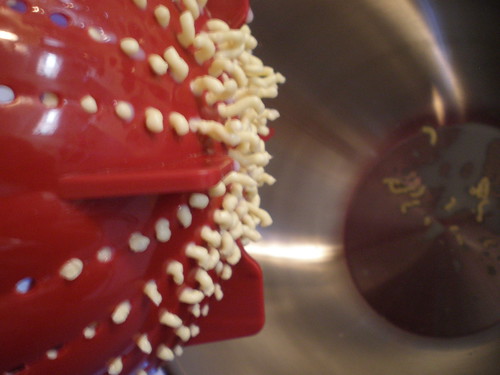Instead of heating and waiting, butter is a totally raw food.
Also unlike yogurt and cheese, butter is a good workout.
Step 1: get some heavy cream (I used raw from the farmers' market and I highly recommend it)
Step 2: put it in a container with a good seal (I used a lock-n-lock container)
 Almost there in this picture
Almost there in this pictureBasically, you first make whipped cream. When you continue shaking after the whipped cream, the cream gets thicker and then breaks down. Continued shaking results in butter and a special splash: buttermilk!
 I didn't get quite as much buttermilk as I expected, but I was ok with that. My recipe called for 1 cup of buttermilk, but I was able to make up for the lack by mixing some leftover cream with water and a squeeze of lemon juice. Ideally, 1 pint of cream, like I had, should yield 1 cup of butter and 1 cup of buttermilk, but I think I got the better part of the deal -- extra butter!
I didn't get quite as much buttermilk as I expected, but I was ok with that. My recipe called for 1 cup of buttermilk, but I was able to make up for the lack by mixing some leftover cream with water and a squeeze of lemon juice. Ideally, 1 pint of cream, like I had, should yield 1 cup of butter and 1 cup of buttermilk, but I think I got the better part of the deal -- extra butter! After the butter has clumped up, drain off the buttermilk. As you can see, I saved it in a measuring cup and carefully refrained from guzzling it myself, but you might not have the same glorious willpower. You're not done just yet, though.
After the butter has clumped up, drain off the buttermilk. As you can see, I saved it in a measuring cup and carefully refrained from guzzling it myself, but you might not have the same glorious willpower. You're not done just yet, though.Throw your butter into a bowl and pour in some water. Knead the butter and dump out the water. Continue this process until the water is clear. Why? You're rinsing off excess buttermilk. If you were to leave it on there, the butter would go off much more rapidly and you'd be left with nasty rancid butter. For my rinsing step, I actually used a colander, but it was a lousy choice, as the picture below demonstrates.

Overall, making butter is easy, sort of fun, and definitely quite an experience. Probably a good science experiment for children, but I don't know the actual science behind the cream to butter process, so I probably won't be using it as a lesson any time soon. Do you know the science behind butter? I've got an interview for Teach for America coming up, and I could use a great mini-lesson. Props are encouraged and I'm sure they wouldn't turn up their noses at some butter time.



5 comments:
Hey lady, if you don't have a stand mixer on your wedding registry yet...put it on there!!! I use ours absolutely all the time for cookies, yeast doughs, etc. and it looks like you can also use it for making lots of butter:
http://www.cookingforengineers.com/article/113/Making-Butter
For the science behind butter, I'd turn to Harold McGee.
http://www.amazon.com/Food-Cooking-Science-Lore-Kitchen/dp/0684800012/ref=pd_bbs_sr_1?ie=UTF8&s=books&qid=1232129166&sr=8-1
As far as making butter, I'm with Jaclyn. I'd put it in the mixer and go lay on the sofa while it was working. :) I do like the idea of working off the calories I'm about to consume.
@Jaclyn: I just added one to our registry! Lately, though, I've been very interested in survivalist food methods... It's fun to make things without help from a machine!
@Meg: thank you for the science link! I'll check that out from the library.
hey i say a post you made on another blog and was wondering if you have any extra pom glasses you might be interested in selling? let me know!
cheers!
nineluckystars@gmail.com
@nineluckystars: Sorry, no dice. I stopped drinking POM when it went out of my budget. Instead, I just stick a sturdy straw into a pomegranate and slurp up the good stuff sans packaging.
Post a Comment